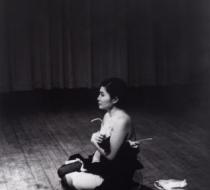Yoko Ono, Cut Piece, 1964 Favorite
In Cut Piece—one of Yoko Ono’s early performance works—the artist sat alone on a stage, dressed in her best suit, with a pair of scissors in front of her. The audience had been instructed that they could take turns approaching her and use the scissors to cut off a small piece of her clothing, which was theirs to keep. Some people approached hesitantly, cutting a small square of fabric from her sleeve or the hem of her skirt. Others came boldly, snipping away the front of her blouse or the straps of her bra. Ono remained motionless and expressionless throughout, until, at her discretion, the performance ended. In reflecting upon the experience recently, the artist said: “When I do the Cut Piece, I get into a trance, and so I don’t feel too frightened.…We usually give something with a purpose…but I wanted to see what they would take….There was a long silence between one person coming up and the next person coming up. And I said it’s fantastic, beautiful music, you know? Ba-ba-ba-ba, cut! Ba-ba-ba-ba, cut! Beautiful poetry, actually.”
Ono debuted Cut Piece in Kyoto, in 1964, and has since reprised it in Tokyo, New York, London, and, most recently, Paris in 2003. It is the realization of what she calls a “score,” a set of written instructions that when followed result in an action, event, performance, or some other kind of experience. As with most of her work—which also encompasses music, poetry, film, sculpture, installation, paintings, and events—the participation of others is often key. Equally conceptual and physical, Cut Piece relies upon audiences’ willingness to interpret and follow the instructions outlining their role. Though participatory art is now more common, Ono was among its pioneers. In works like Cut Piece, she invites viewers to become agents in the creation of art.
Cut Piece—in dialogue with Fluxus and her other work—generates feminist political readings. Visual culture of the atomic war to confront the influence of the bombings of Hiroshima and Nagasaki on postwar Japanese art. Integrating Ono into broadly understood feminism—direct itself toward the circulation of the female body within global politics —a gendered body and one formed by nation, race, and history. But could the piece be a positive statement? One that offers “gift, a gesture of reparation, or a ritual of remembrance”.







